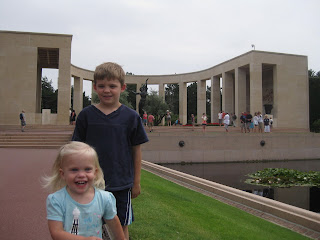This was a great day of WWII Normandy beach positions we grouped together. The kids really seemed to like getting out and climbing all over everything. We have family making a trip to Normandy next week which was great incentive for me to hurry up and get this posted!
Longues-sur-mer German Battery
Here's McKay and Morgan running because they can! It was really cool to be able to walk all over these casemates inside and out.



I'm just going to use the great summary I found at www.normandiememoire.com here to explain the site's significance:
- Built in the first few months of 1944, the naval battery at Longues was equipped with four 150-mm guns, housed in thick cement casemates, and a range-finding post embedded in the cliff face.
- Thanks to the range of its guns, the battery could fire on both the Omaha (American sector) and Gold (British sector) beaches.
- Athough it was heavily bombed prior to D-Day, it was still capable of opening fire on the invasion fleet in the morning of June 6, 1944. At daybreak, it engaged in a duel with several Allied cruisers before being silenced in the evening. The next day, it was captured by the British without a fight. [There's a great account of the battle in Ambrose's D-Day book where the French resistance had previously gotten one of the gun's coordinates to the Allies. HMS Ajax was able to zero in on it and of the casements there, you can see that one gun was blown to bits and is still laying there.]
- Longues Battery is the only one in the region to have kept its guns, and because of its excellent state of preservation, it is well worth a visit.
Here's the view from the top of one looking north to Port Winston and the British and Canadian landing beaches. Nothing but corn fields behind us.
The range-finding post:
The boys aren't quite tall enough to be up to the task yet. The Longest Day movie had a good part about what it'd have been like to be in here on D-Day.
Walking down the path that lead to the shore below the range-finder you can see Port Winston in the distance.
American Military Cemetery at Coleville
Next we stopped at the American Cemetery at Coleville. As we entered, my senses were overwhelmed with how well-cared for this piece of ground was. Truly hallowed ground.
As we walked around a corner to the memorial, the scent of fresh mown grass and crisply edged walkways met us. The somber memorial to the missing with 1,557 names reminded me how lucky Papa was to be from the West because by far the majority of names were from east of the Mississippi. Then the monument to the campaigns, the beautiful wrenching "Spirit of American Youth" sculpture and reflecting lily pond. On to the meticulously kept burial area with rose gardens in each section. Workers carefully walking the rows scuffing debri off each marker they passed. Hushed reverent voices of visitors pausing to read a headstone. Occasional squeals of little ones eager to stretch their legs. It was an experience I feel words and pictures don't do justice. All those young men, all those families so far away. Soldiers' families were given the choice of whether to bring their soldier home for burial or have them buried here. There are 9,387 soldiers here.
Morgan's down there at the end in her sprint to the finish.


After the cemetery, we drove along the beachfront of Omaha but didn't get out. There's not much left of D-Day on the beaches and we opted out of stopping at each museum. I read bits of Ambrose's book now and then throughout this trip to give us a bit of context for what we'd see and we often referred to Ambrose's maps and diagrams. However, on the way home from our entire Normandy trip, we listened to Ambrose's entire D-Day book (6 hrs). I highly recommend this approach because we now had mental images of many of the places being mentioned. Between that and watching "The Longest Day" and "Saving Private Ryan", I think Ryan and I feel like we have a itty bitty handle on that horrific, historic campaign.
Pointe du Hoc
Army rangers had to scale a cliff under fire and take out six big guns in order to link up the two American landing beaches of Omaha and Utah. They accomplished their mission but suffered 70 percent casualties. Naval and air bombardment left huge craters that are still visible today. They're huge! The scrub brush all over serves as natural barbed wire in addition to the real barbed wire. It must have been a horrible, horrible place for those Rangers! I forgot our camera so these pics are from online travel forums.


The boys really loved climbing inside bunkers and popping out another hole. I was so nervous Morgan was going to fall into something and get banged up. But I'm so glad we stopped here to see it! This site has a good overview of the mission and outcome, while Ambrose's book and "The Longest Day" give narrative and visuals to the actual experiences.











